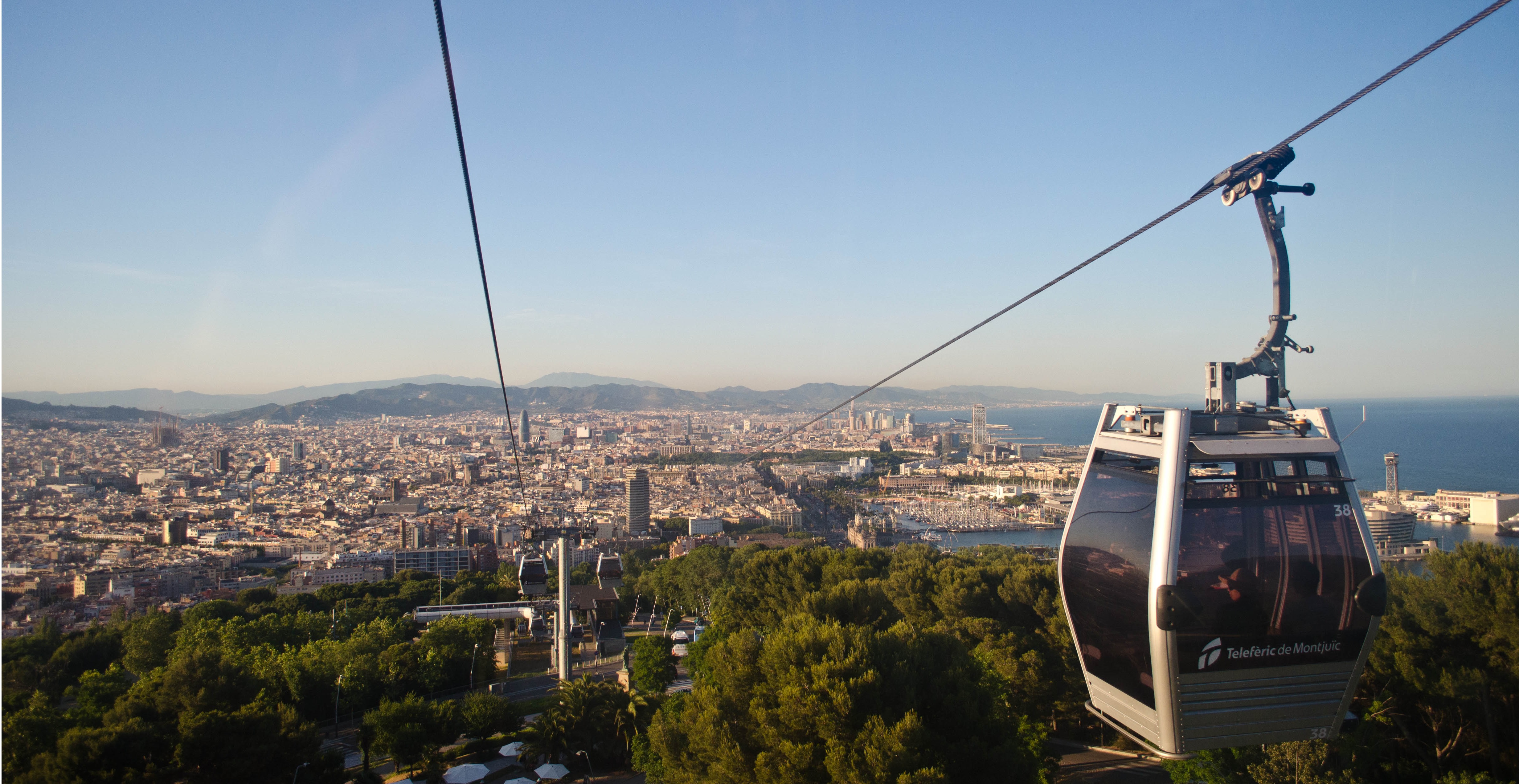
Montjuic stands as Mount of Jewish in Medieval Catalan language, due to the belief that there was a sacred Jewish cemetery in the mountain during that time. It was a reference point in the 18th Century, as the measure from Dunkerque (France) to Montjuic (Barcelona) helped establish the decimal metric system, and at 173 meters tall over the sea, it is the highest mountain in Barcelona.
To access the mountain you can use the cable car (see point 3) or the Funicular (you have to take it at Paral.lel station).
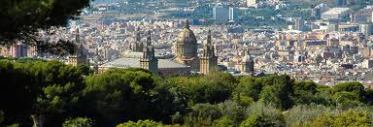
1. Castle of Barcelona
Built in 1640, the Castle of Barcelona is established at the top of the mountain of Montjuic to preserve Barcelona of attacks coming from the sea, including pirates, as the vision range from the castle is quite vast. During the years it has been converted into a military prison. In 1919, during the revolutionary anarchy that invaded Barcelona, over 3000 workers were made prisoners here. Also, during Spanish civil war, 173 people were executed in the Castle, mainly Catalan politicians. Entrance is free.
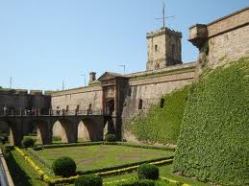
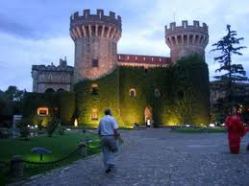
2. Teatre Grec / Joan Miró Foundation
The Greek Theatre was built in 1929 as a replica of old Greek theatres, and they quite accomplished their goal of transporting you back to Greek times. Now including a close-by restaurant, every July holds the Grec Festival (including art, music, dance and theatre). The capacity of 1900 people is filled every day during the festival!
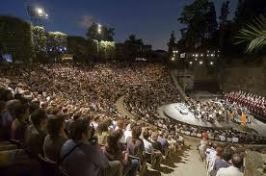
Also, just across the street you will be able to find the museum of one of the Worldwide known Catalan artist Joan Miró. His museum is located just facing the Greek Theatre. If you feel like visiting one of the world’s most known abstract paintings, you just have to cross the street!
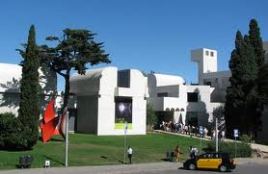
3. Mies van der Rohe Pavillion / CaixaForum
Mies van Rohe established in 1929 the Barcelona Pavillion (which held the German Exhibition), as part of the International Exhibition held in the city in such date. It can be understood as a futuristic art deco building, as it is still nowadays considered a pioneer in design (although it’s 83 years old!). The Mies van der Rohe design museum it is inside.
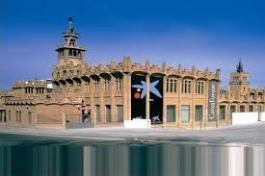
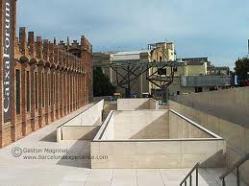
CosmoCaixa is a restored modernist building that is nowadays Barcelona’s largest free admission museum. It holds many temporary collections including Caravaggio. It is worth a visit since is free!
4. Olympic Stadium
In 1992, Barcelona held the Summer Olympic Games. Due to that, the area in which the Olympic stadium is now was made from zero, as at the time they were barracks and fields.
With the arrival of the Summer Games, the Olympic Stadium was raised, and so, the Palau Sant Jordi (by Arata Isozaki), and the Olympic Antenna (by Santiago Calatrava). Both the antenna and the Palau were architectonic shocks at the time, and still nowadays are two of the icons of Barcelona’s skyline. On the top picture: Palau Sant Jordi (left) and Olympic Antenna (right). On the bottom picture: Olympic Stadium.
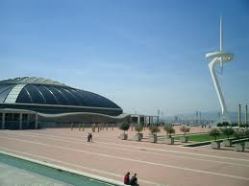
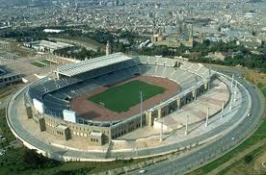
5. Cable Baskets http://www.tmb.cat/es/teleferic-de-montjuic
One of Montjuic’s trademarks is the cable car baskets that will bring you around the mountain. You can consult fares and timetables in the web provided. There are two lines:
- The first one will bring you from the Funicular Station up to the Castle, enjoying the sights of the Mountain.
- The second one brings you from Miramar up to la Barceloneta (Barcelona’s most known beach) through the air!
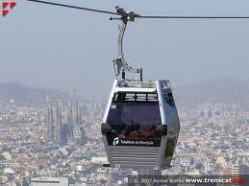
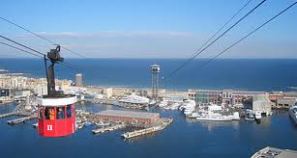
6. Poble Espanyol http://www.poble-espanyol.com
Possibly, the most visited attraction in the whole Montjuic. Some concerts take place here, but regularly it offers an insight to the whole Spain within the same place. It can be understood as a “Spain in Miniature”, as you can find replicas of the most famous Spanish monuments and landscapes.
Some artisans also have their stores here and it is well known around Barcelona for having the best artisans with glass and clay. Also, with the entry ticket you have access to “El Tablao de Carmen”, one of Barcelona’s most famous flamenco tablaos.

7. Plaza Espanya complex / MNAC / Magic Fountain
Close to Plaza Espanya we can find three things converging. First, the Plaza Espanya itself, with the brand new shopping mall Arenas (what used to be a bullfighting arena), together with the complex of Europe’s largest fair convention center, called Fira de Barcelona, and its famous Venetian towers.
But probably what will catch your eye will be the MNAC (Museu Nacional d’Art de Cataunya – National Museum of Catalan Art) http://www.mnac.cat/index.jsp?lan=001 .The building was built in 1929, but the actual museum is a merger of the ModernArt Museum (1945) and CatalonianArt Museum (1934). It holds the world’s largest and best art collection of the Romanic Period.
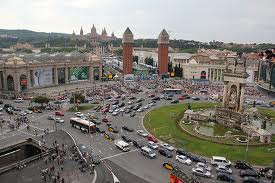
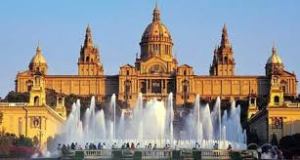
The last must in this area is well known in Barcelona and is known as the Magic Fountain. A show of the fountains with music and colour creates the delight of thousands of tourists every week. The light and music performances from October to April take place on Fridays and Saturdays every half-hour between 19:00 and 20:30. From May to September, Thursday through Sunday every half-hour between 21:00 and 23:00.

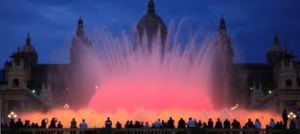

You completed some good points there. I did a search on the
issue and found nearly all
persons will agree with your blog.